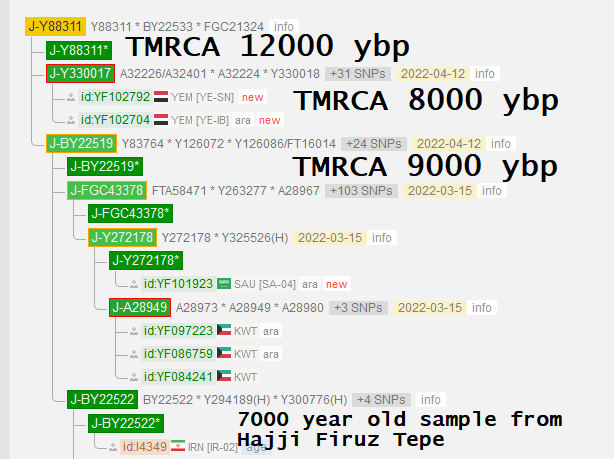Over the past two years I've become gradually more interested in the diversity of J2b in the Middle East.
Background
Rare line J2b-Z2453 has, until now, not afforded much in the way of Bronze Age or older lineages with modern samples tracing descent to a consistent region of the Middle East.
Despite that, the 7000 year old sample I4349 from Hajji Firuz Tepe (Iran), the second oldest ancient J2b sample found, has at least been useful for confirming an ancient presence of J2b in the Zagros Mountains, consistent with the oldest J2b from Tepe Abdul Hosein dating to 10000 years ago, sample AH2.
Article on AH2 by Chris Rottensteiner and Ted Kandell (July 2016)
There is another ancient J2b-Z2453 sample, from Alalakh, Syria dating to 3780 ybp, Late Bronze Age. It isn't included on the YFull tree due to low coverage but has been classified as J2b-Y31143. I'm not sure if it has been confirmed negative for the several SNPs defining the new Yemen/Hajji Firuz Tepe ancestor line I describe in the "Yemen" section below.
Also worth noting is that the closest relatives to the Ashkenazi Jewish lineages of J2b-Z2453>..>Z42983 are from Qatar. Their TMRCA lived about 5200 years ago. Their next closest relatives at 7400 ybp TMRCA are from Medina and then, one more branch back at 10500 ybp TMRCA are from Wasit, Iraq.
Armenian Diversity
Another new development is that another sample from Armenia, tracing descent to Aragatsotn, looks to establish Iron Age diversity in Armenia for the lineage J-Y45371
J-Y45371's very long bottleneck is now increasing from 74 to 85 SNPs. It'll be helpful for our research into the deeper origins of this line to find some samples splitting this bottleneck that began 12400 years ago and ended in the Iron Age.
Yemen
The two recent samples from Sanaa and Ibb, Yemen, have split line J2b-BY22519, only being positive for three of its SNPs. This bottleneck was estimated by YFull to have begun forming 12400 years ago.
Both of these lines are now shown to descend from a man who was positive for J2b-Y88311 and lived about 12000 years ago.

A back-of-the-envelope calculation gives me 8000 ybp for the TMRCA of Yemen line J2b-Y330017. This is not proof that their ancestor was living in Yemen 8000 years ago but this is one possible interpretation.
Agriculture Spread from the Near East 8000 Years Ago
8000 ybp is the approximate date given for the eastern diffusion of agriculture in The genetics of an early Neolithic pastoralist from the Zagros, Iran (Gallego-Llorente et alii 2016):
It is possible that farmers related to GD13a contributed to the eastern diffusion of agriculture from the Near East that reached Turkmenistan32 by the 6th millennium BP, and continued further east to the Indus Valley.
One line of J2b is strongly associated in time and direction with this diffusion of agriculture to the east, J2b-Z2433. Here is an article I wrote about this connection back in 2019. The gist is still relevant though the TMRCA estimates are now more refined. I plan to write an update soon regarding a new branching point below J2b-Z2433 called FT282078 that was recently discovered to contain samples from Haryana, India and Maysan, Iraq (near Iran border).
I do not know when pastoralism/agriculture was introduced to Yemen and to my knowledge there are no ancient samples from Yemen that have been genetically sequenced.
If pastoralism/agriculture was introduced to Yemen at the same time that it spread in other directions, we might consider that J2b-Y330017 may have migrated to Yemen at that time, about 8000 years ago, from a place where we know ancient J2b has been found among pastoralists, the Zagros Mountains.
We also cannot rule out that some lineages of J2b-Z2453 may have already been living in the Arabian Peninsula as hunter-gatherers prior to these developments. After all, J2b-Z2453 itself has a TMRCA of 13400 years ago. By 8000 year ago, this lineage could already have become widely dispersed throughout the Near East, rather than having been confined to just the Zagros Mountains where we have found ancient samples.
Related reading, The Neolithic Dispersal into Arabia (P. Drechsler 2007).
Please contact me with more up-to-date articles concerning the spread of agriculture into Arabia and I will list them here.